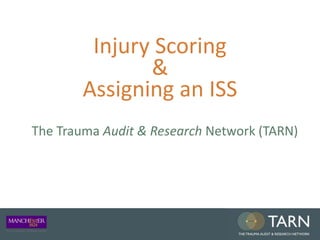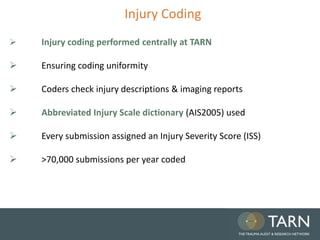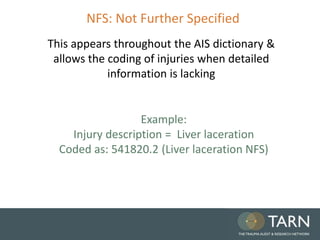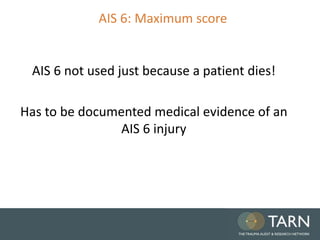6. AIS angfdfgfffggggggggggfffcfd ISS.pptx
- 1. Injury Scoring & Assigning an ISS The Trauma Audit & Research Network (TARN)
- 2. ’āś Injury coding performed centrally at TARN ’āś Ensuring coding uniformity ’āś Coders check injury descriptions & imaging reports ’āś Abbreviated Injury Scale dictionary (AIS2005) used ’āś Every submission assigned an Injury Severity Score (ISS) ’āś >70,000 submissions per year coded Injury Coding
- 3. Abbreviated Injury Scale: AIS ’āś THE Internationally recognised system for injury scoring ’āś Produced by AAAM (Association for the Advancement of Automotive Medicine) in U.S.A ’āś Introduced in 1970, originally for Vehicle Crash investigators ’āś Latest version: AIS2005 >2000 injury descriptors ’āś Anatomically based system, ranking injuries according to severity on a 6 point ordinal scale
- 4. AIS: 6 point severity scale AIS (Severity) Grade Injury example 1 Minor Bruise to abdomen 2 Moderate Small Liver laceration 3 Serious Liver laceration with >1 litre of blood loss 4 Severe Ruptured liver 5 Critical Liver laceration involving hepatic vessels 6 Maximum Avulsed liver
- 5. AIS Severity indicates The relative risk of ŌĆ£threat to lifeŌĆØ in an average person who sustains the coded injury as his or her only injury ItŌĆÖs not a disability scale
- 6. AIS code structure: 7 digits Code Injury Numerical identifier Severity Score 853271.3 Comminuted Femoral Shaft # 853271 .3 140656.5 Large Subdural haemorrhage 140656 .5
- 7. Abbreviated Injury Scale: Sections Skin Degloving Penetrating Hypothermia Crush Asphyxia: Hanging/Strangulation Traumatic Amputation Drowning Nerve Frostbite Vessel Burns Joint Inhalation Skeletal Electrocution
- 8. AIS: Spinal Injuries ’āś Cervical Spine (C1-C7) ’āś Thoracic Spine (T1-T12) ’āś Lumbar spine (L1-L5) Severity can be affected by location of spinal injury
- 9. AIS: Confirmed injuries only Suspected injuries ’ā╗ Possible injuries ’ā╗ Probable injuries ’ā╗ Ruled out injuries ’ā╗
- 10. AIS: Not Coded ’āś Infections ’āś Pneumonia ’āś Death ’āś Blindness ’āś Miscarriage ’āś Epilepsy following head injury ’āś Pulmonary embolism following skeletal injury DonŌĆÖt affect Severity score
- 11. NFS: Not Further Specified This appears throughout the AIS dictionary & allows the coding of injuries when detailed information is lacking Example: Injury description = Liver laceration Coded as: 541820.2 (Liver laceration NFS)
- 12. AIS 6: Maximum score AIS 6 not used just because a patient dies! Has to be documented medical evidence of an AIS 6 injury
- 13. AIS 6: Maximum score Head or Neck ’āśBrain stem: laceration, crush, penetrating or transection ’āśC3 or higher complete cord transection or contusion ’āśSigmoid or Transverse sinus or Internal carotid artery: Bilateral lacerations Thorax ’āś Heart: rupture, multiple lacerations or avulsion ’āś Total chest crush ’āś Aortic rupture + haemorrhage not confined to mediastinum ’āś Bilateral pulmonary artery or vein transection ’āś Severe inhalation Abdominal & Pelvic contents ’āś Liver avulsion External ’āś 2nd or 3rd degree burns > 90% Total Body Surface ’āś Massive Whole body Explosion type injury
- 14. AIS: Localisers 2 additional localiser codes, allow coding of: ’āśLocaliser 1 Side or aspect of an injury e.g. Right, left, Upper, Temporal, Frontal ’āśLocaliser 2 Actual Site of an injury e.g. 5th rib, 12th Thoracic vertebrae, 2nd toe Numerical identifier Severity Localiser 1 Localiser 2
- 15. AIS dictionary www.aaam.org Latest Version: AIS 2005 (Update 2008) $250 each
- 17. Spiral Fracture of left Shaft of Femur 147 Open Comminuted fracture to Tibial Shaft 149 Vertical Shear fracture to left side of pelvis with blood loss >20% 159 5 ribs fractured on left 82 Subdural haematoma bilateral & 2cm thick on both sides 46 Base of skull fracture 49 Full thickness Rectal laceration 95 853251.3 854272.3 856173.5 450203.3 140655.5 150200.3 543624.3 EXAMPLE SUBMISSION 1: INJURIES Page AIS code
- 18. Calculating the ISS Injury Severity Score
- 19. Calculating the ISS: Step 1 Determine the scores of the individual injuries using the Abbreviated Injury Scale
- 20. Calculating the ISS: Step 2 Identify the highest severity score in each body area
- 21. Injury Severity Score: 6 body areas ’āśHead & Neck & Cervical spine ’āśFace ’āśChest & Thoracic spine ’āśAbdomen & pelvic contents & Lumbar spine ’āśExtremities & bony pelvis ’āśExternal (incl. Skin injuries and Burns)
- 22. Head Subdural haematoma bilateral & 2cm thick on both sides 140655.5 Base of skull fracture 150200.3 Thorax 5 ribs fractured on left 450203.3 Abdomen Full thickness Rectal laceration 543624.3 Extremities Spiral Fracture of left Shaft of Femur 853251.3 Vertical Shear fracture to left side of pelvis with blood loss >20% 856173.5 Open Comminuted fracture to Tibial Shaft 854272.3
- 23. Calculating the ISS: Step 3 Square the highest score in each body area
- 24. Head Subdural haematoma bilateral & 2cm thick on both sides 140655.5 Base of skull fracture 150200.3 Thorax 5 ribs fractured on left 450203.3 Abdomen Full thickness Rectal laceration 543624.3 Extremities Spiral Fracture of left Shaft of Femur 853251.3 Vertical Shear fracture to left side of pelvis with blood loss >20% 856173.5 Open Comminuted fracture to Tibial Shaft 854272.3 5┬▓ =25 5┬▓ = 25 3┬▓ =9 3┬▓ =9
- 25. Calculating the ISS: Step 4 ’āśCode individual injuries ’āśIdentify the highest score in each body area ’āśSquare the highest score in each body area ’āśAdd together the highest AIS2 from 3 different body areas
- 26. Head Subdural haematoma bilateral & 2cm thick on both sides 140655.5 Base of skull fracture 150200.3 Thorax 5 ribs fractured on left 450203.3 Abdomen Full thickness Rectal laceration 543624.3 Extremities Spiral Fracture of left Shaft of Femur 853251.3 Vertical Shear fracture to left side of pelvis with blood loss >20% 856173.5 Open Comminuted fracture to Tibial Shaft 854272.3 5┬▓ =25 5┬▓ = 25 3┬▓ =9 3┬▓ =9
- 27. Injury Severity Score (ISS) = 59
- 28. Body area Injury AIS code Head Closed vault fracture 150402.2 Thorax 5+6 ribs fractured on left 450202.2 ISS = 8 Injury Severity Score (ISS) 2┬▓ = 4 2┬▓ = 4
- 29. Injury Severity Score (ISS) ’āśRanges from 1 to 75 ’āśMaximum 75 achieved in 2 ways: 1. Severity 5 in 3 different body areas 52 + 52 + 52 = 75 2. ISS convention: AIS = 6 in any body area, ISS = 75
- 30. Importance of Injury Detail ’āśLength, depth or Grade of lacerations (especially to internal organs) ’āśDepth, size and location of haemorrhages and contusions (especially in the brain) ’āśOpen or Closed fractures ’āśStability & site of Fractures (e.g. Comminuted/Displaced Shaft/Proximal/Distal fracture) ’āśArticular (joint) involvement (e.g. Intra-articular, extra-articular) ’āśBlood loss ’āśVessel damage ’āśLocation & number of rib fractures ’āśCompression or effacement of ventricles/brain stem cisterns ’āśNeurology associated with spinal cord injuries ’āśInstability, Blood loss or Vascular damage associated with Pelvic Fractures ’āśCardiac arrest associated with asphyxia or drowning ’āśEnsure all injuries are documented ’āśInclude imaging reports or Post Mortems for every submission.
- 31. Questions
Editor's Notes
- #29: This patient has 3 different injuries. 2 body regions injuries Highest scores are 9 (Thorax) and 4 (Head). ISS = 13






























